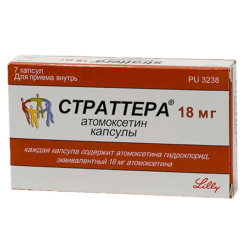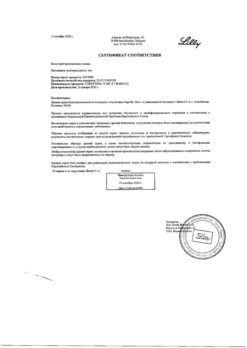No products in the cart.
Levetiracetam, 250 mg 30 pcs
€14.55 €12.73
Description
The mechanism of action of levetiracetam has not been fully identified, but it differs from the mechanism of action of other anticonvulsants. In in vitro and in vivo experiments it is shown that levetiracetam does not affect the basic properties of the cell and normal nerve transmission.
In in vitro studies it has been shown that by partially reducing N-type calcium currents and reducing the release of calcium ions from intracellular neuronal depots, levetiracetam alters the concentration of calcium ions within neurons. In addition, it partially eliminates the reduction of currents induced by zinc- and B-carbolines through GABA- and glycine-dependent channels.
One proposed mechanism is based on the proven binding to the glycoprotein of synaptic vesicles SV2A contained in the gray matter of the brain and spinal cord. It is believed that in this way the anticonvulsant effect is realized, which is expressed in opposition to hypersynchronization of neuronal activity.
Levetiracetam also affects GABA and glycine receptors, modulating these receptors through various endogenous agents. do not alter normal neurotransmission, but suppress epileptiform neuronal bursts induced by the GABA agonist bicuculline, and excitation of glutamate receptors.
Indications
Indications
For the treatment of partial seizures with or without secondary generalization in patients over 16 years of age with a newly diagnosed epilepsy.
As an adjuvant therapy, levetiracetam is indicated for the treatment of:
partial seizures with or without secondary generalization in patients with epilepsy from 6 years of age
myoclonic seizures in patients with juvenile myoclonic epilepsy from 12 years of age and adults
primary generalized tonic-clinical seizures in patients with idiopathic generalized epilepsy from 12 years of age and adults
Pharmacological effect
Pharmacological effect
The mechanism of action of levetiracetam is not fully understood, but it differs from the mechanism of action of other anticonvulsants. In vitro and in vivo experiments have shown that levetiracetam does not affect the basic properties of the cell and normal nerve transmission.
In vitro studies have shown that, by partially reducing N-type calcium currents and reducing the release of calcium ions from the intracellular stores of neurons, levetiracetam alters the concentration of calcium ions inside neurons. In addition to this, it partially eliminates the decrease in currents caused by zinc and B-carbolines through GABA- and glycine-dependent channels.
One of the proposed mechanisms is based on proven binding to the synaptic vesicle glycoprotein SV2A, contained in the gray matter of the brain and spinal cord. It is believed that in this way an anticonvulsant effect is realized, which is expressed in counteracting the hypersynchronization of neural activity.
Levetiracetam also acts on GABA receptors and glycine receptors, modulating these receptors through various endogenous agents. do not change normal neurotransmission, but suppresses epileptiform neuronal bursts induced by the GABA agonist bicuculline and excitation of glutamate receptors.
Special instructions
Special instructions
It is advisable to gradually discontinue concomitant antiepileptic drugs (during the period of transfer of patients to levetiracetam).
For patients with kidney disease and decompensated liver disease, a kidney function test is recommended before starting treatment. Due to reports of suicide, suicidal ideation and suicide attempts during treatment with levetiracetam, patients should be warned to immediately notify their physician of any symptoms of depression or suicidal ideation.
Impact on the ability to drive vehicles and machinery
Due to varying individual sensitivity to levetiracetam on the part of the central nervous system, during the treatment period, patients should refrain from driving vehicles and engaging in potentially hazardous activities that require increased concentration and speed of psychomotor reactions.
Active ingredient
Active ingredient
Levetiracetam
Composition
Composition
Composition per 1 tablet: levetiracetam – 250.00 mg.
Pregnancy
Pregnancy
Adequate and strictly controlled clinical studies on the safety of levetiracetam in pregnant women have not been conducted, therefore levetiracetam should not be used during pregnancy unless absolutely necessary.
Physiological changes in a woman’s body during pregnancy may affect plasma concentrations of levetiracetam, as well as other antiepileptic drugs. During pregnancy, a decrease in plasma concentrations of levetiracetam was observed.
This decrease is more pronounced in the first trimester (up to 60% of the baseline concentration in the period preceding pregnancy).
Treatment with levetiracetam in pregnant women should be carried out under special supervision. It should be borne in mind that interruptions in antiepileptic therapy can lead to a worsening of the disease, which is harmful for both the mother and the fetus.
Levetiracetam is excreted in breast milk, so breastfeeding is not recommended during treatment. However, if treatment with levetiracetam is necessary during lactation, the risk/benefit ratio of treatment should be carefully weighed against the importance of breastfeeding.
Contraindications
Contraindications
Hypersensitivity to levetiracetam or pyrrolidone derivatives, other components of the drug. Children’s age up to 6 years.
Side Effects
Side Effects
From the hematopoietic system: infrequently – thrombocytopenia, leukopenia; rarely – neutropenia, pancytopemia.
Metabolism: often – anorexia; infrequently – increase/decrease in body weight.
From the side of the central nervous system: very often – drowsiness, headache; often – mood swings, emotional lability, depression, aggressiveness, insomnia, nervousness; uncommon – conduct disorder, anger, anxiety, hallucinations, psychotic disorders, memory impairment, suicide attempt. obsessions, amnesia, tactile sensitivity disorder, dizziness, headache, hyperkinesia, tremor, imbalance, absent-mindedness, paresthesia; rarely – personality disorder, incl. thinking disorder, suicide, hyperkinesis, choreoathetosis.
From the senses: often – dizziness; infrequently – diplopia, blurred vision.
From the respiratory system: often – cough.
From the digestive system: often – nausea, vomiting, diarrhea, abdominal pain, dyspepsia; infrequently – deviations of laboratory parameters of liver function from the norm; rarely – pancreatitis, hepatitis, liver failure.
From the skin and subcutaneous tissues: often – skin rash; uncommon – eczema, itchy skin; rarely – alopecia (in some cases, resolving after discontinuation of levetiracetam), toxic epidermal necrolysis, erythema multiforme, Stevens-Johnson syndrome.
From the musculoskeletal system: infrequently – myalgia, muscle weakness.
Other: often – general weakness, fatigue; infrequently – nasopharyngitis, accidental trauma.
In children, most often: vomiting, agitation, mood swings, aggression, emotional lability, behavior disorder, lethargy.
Interaction
Interaction
When taken together with topiramate, the likelihood of developing anorexia is higher.
The completeness of absorption of levetiracetam does not change under the influence of food, but the rate of absorption is slightly reduced.
Manufacturer
Manufacturer
Ozon, Russia
Additional information
| Manufacturer | Ozon, Russia |
|---|---|
| Medication form | pills |
| Brand | Ozon |
Related products
Buy Levetiracetam, 250 mg 30 pcs with delivery to USA, UK, Europe and over 120 other countries.













